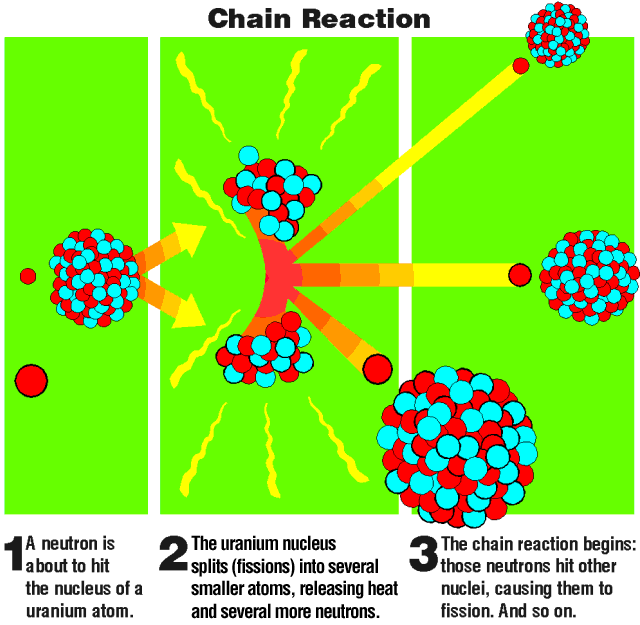
Nicholas L. Sharp
17 Aug. 2005
Nuclear Power
Nuclear power is one of the best alternative energy sources to fossil fuels available for large-scale employment. Nuclear reactors come in several varieties, the most common of which is the light water reactor. Many of the popular arguments against nuclear power are either fallacious or minimal compared to fossil-fuel arguments.
Within a typical nuclear reactor, uranium-235 nuclei are undergoing nuclear fission. When a nucleus undergoes fission, it splits into two smaller nuclei and releases two to three neutrons in the process ("Nuclear Energy"). These neutrons then go on to cause more fissions, creating a chain reaction (see illustration 1) ("Nuclear Energy"). The fission of a kilogram of uranium-235 releases 2.5 million times more energy than a kilogram of carbon undergoing oxidation (see illustration 2) (Rahn 174). The power produced by the reaction is controlled by the insertion or removal of neutron-absorbing control rods ("Nuclear Energy"). The positions of the rods determine the nuclear reactor's ability to sustain itself ("Nuclear Energy"). Reactors often have what is called a moderator, something which reduces the kinetic energy of the neutrons without capturing many of them ("Nuclear reactors" 796). Light and heavy water, carbon, and beryllium all act as good moderators ("Nuclear reactors" 796).
Nuclear power plants (NPPs) (see illustrations 3 and 4) can produce anywhere from 40 to 2,000 megawatts of electricity (Parris). As of 2000, there were about 438 NPPs in operation around the world, producing approximately seventeen percent (351 gigawatts) of the world's electric power (EI C). As of 2004, there were 104 NPPs (69 PWRs and 35 BWRs) in the United States, producing twenty percent (97.4 gigawatts) of the nation's electricity (EI C). The United States is the world's largest supplier of commercial nuclear power (EI C). As of 2002, 78% of France's electric power was generated by nuclear reactors, while in the United States as of 2001, only 19% of the country's electricity was produced by nuclear reactors (EI C). Since the Three Mile Island incident in 1979, there has been an unofficial moratorium on the construction of nuclear power plants within the United States (see illustration 5) ("Nuclear Energy"). This is probably a result of the irrational fear of the American public of all things nuclear. A perfect example of this is the changing the name of the non-invasive harmless nuclear magnetic resonance imaging (NMRI) to magnetic resonance imaging (MRI), for fear that the public would fear it despite the fact that it has nothing to do with radiation.
In a nuclear reactor, great heat (thermal energy) is released by the fissioning uranium, which is then turned into electricity via a steam turbine and generator (EI C). Light-water reactors (LWRs) use highly purified ordinary water (H2O) as moderator and coolant for the isotopically enriched (to about three percent uranium-235) uranium oxide fuel ("Nuclear Energy"). In a pressurized-water reactor (PWR) (see illustration 6), a type of LWR, water is pressurized to about 150 atmospheres (atm) and pumped through the reactor core, where it is heated to about 325°C ("Nuclear Energy"). The thermal energy of the superheated water is transferred, via heat exchangers, to a secondary loop of water which is converted to steam ("Nuclear Energy"). The steam in the secondary loop drives the turbine generator, condenses, and is then heated again by the superheated water in the primary loop ("Nuclear Energy"). The secondary loop (which goes through the steam turbine) is isolated from the radioactive primary loop (which goes through the reactor core) ("Nuclear Energy").
In boiling-water reactors (BWRs), another type of LWR (see illustrations 7 and 8), the water coolant is allowed to boil within the core by operating at lower pressures ("Nuclear Energy"). The steam is then used to directly run the turbine generator ("Nuclear Energy"). There is no isolated secondary loop in the BWR, so the steam is radioactive, but there is a large increase in efficiency due to the nonuse of an intermediate heat exchanger ("Nuclear Energy").
During the operation and after the shutdown of a gigawatt nuclear reactor, the reactor has billions of curies of radioactivity ("Nuclear Energy"). The thick concrete shield surrounding the reactor absorbs the radiation from the reactor and from the fission products after shutdown ("Nuclear Energy"). In the event of a leak or meltdown, there is a large steel and concrete containment building (see illustration 9) and an auxiliary cooling system ("Nuclear Energy").
Breeder reactors produce more fuel than they consume by transmuting uranium-238 into plutonium via excess neutron absorption ("Nuclear Energy"). A popular type of breeder reactor is the liquid-metal fast breeder reactor (LMFBR) (see illustration 10) ("Nuclear Energy"). LMFBRs use liquid sodium as the preferred coolant liquid ("Nuclear Energy"). Some drawbacks of LMFBRs include the fact that sodium is highly reactive with both air and water and that sodium easily becomes radioactive ("Nuclear Energy"). LMFBRs produce twenty percent more fuel than they consume, enough to create another reactor in twenty years ("Nuclear Energy"). LMFBRs use 75% of the available energy in uranium, in contrast to only 1% for LWRs ("Nuclear Energy").
Nuclear power generation does not produce many of the pollutants associated with the combustion of fossil fuels such as carbon dioxide, sulfur dioxide, nitrogen oxides, mercury, and particulates (EI C). Nuclear power plants produce far less waste material than fossil-fuel power plants (EI C). Also, coal power plants are known for producing large amounts of radioactive ash due to concentrating naturally occurring radioactive material in the coal (EI C). Less than one percent of industrial toxic waste is from nuclear power plants (EI C). Unlike most industrial toxic waste, which remains hazardous indefinitely, radioactive waste becomes safe after extended periods of time. The statistics regarding human deaths from occupational accidents are much more favorable for the nuclear industry than for coal or hydropower (EI C). Comments saying that people will be exposed to more radiation with the construction of more nuclear power plants are mostly ill-informed. Most human exposure to radiation comes from naturally occurring background radiation, the rest coming from medical procedures (EI C). Studies have shown that there is no increase in cancer mortality for people living near nuclear facilities (EI C). Wind power has been shown to be twice as expensive as nuclear power (EI C).
The Chernobyl incident (see illustration 11) is often extolled as the pinnacle of the evils of nuclear power, yet it can be shown that it was caused by a faulty reactor design, the lack of a containment building, poorly trained operators, and a non-existent safety culture (EI C). As of 2003, the United States has accumulated about 49,000 tonnes of spent nuclear fuel from reactors (EI C). Unlike other countries, American policy forbids the recycling of used fuel and treats it as waste (EI C). After 10,000 years of radioactive decay, the spent nuclear fuel will no longer pose a threat to public health and safety according to the American Environmental Protection Agency standards (EI C). Nuclear power plants have large construction costs and long construction periods (Parris). There are also high maintenance costs and a high cost of decommissioning plants (Parris). Nuclear power is only available as large-scale plants (Parris). Nuclear accidents have the capability to be of catastrophic proportions (Parris).
In the future, uranium could be extracted from seawater or granite (EI C). Thorium, being three times more abundant in the Terran crust than uranium, is another alternative for fission fuel (EI C). The current popular light water reactor design uses its fuel inefficiently, wasting energy (EI C). More efficient reactors or fuel reprocessing would reduce waste and lead to better use of available resources (EI C). Current light water reactors use uranium-235 (0.7% of naturally occurring uranium), while fast breeder reactors use uranium-238 (99.3% of naturally occurring uranium) (EI C). It has been estimated that there is anywhere between ten thousand and five billion years worth of uranium-238 fuel for fast breeder reactors (EI C). Breeder technology has already been incorporated into several reactors (EI C). After a peak in oil and natural gas production has been reached, nuclear power and coal will be the only realistic large-scale energy sources remaining (EI C). Cheap American uranium reserves consist of about two million to five million tonnes (EI C). If it is two million tonnes, an LWR nuclear power system providing thirty percent of American power will only last fifty years due to the inefficient use of uranium (EI C). LWRs use only about one percent of the energy available from the uranium (EI C).
Despite the current highly inefficient use of uranium in LWRs, nuclear power still remains one of the most used alternative energy sources to fossil fuels and the best option for future electricity production. It seems as if the benefits of the use of nuclear power greatly outweigh the negative aspects.
Illustration 1: chain reaction

<http://www.nrc.gov/reading-rm/basic-ref/teachers/chain-reaction.html>
Illustration 2: uranium-to-fossil-fuel comparision
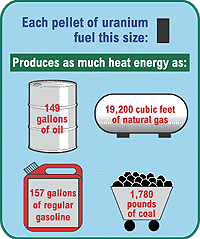
<http://www.oncorgroup.com/community/education/knowledgecollege/energy_library/elec_nuc.asp>
Illustration 3: nuclear power plant
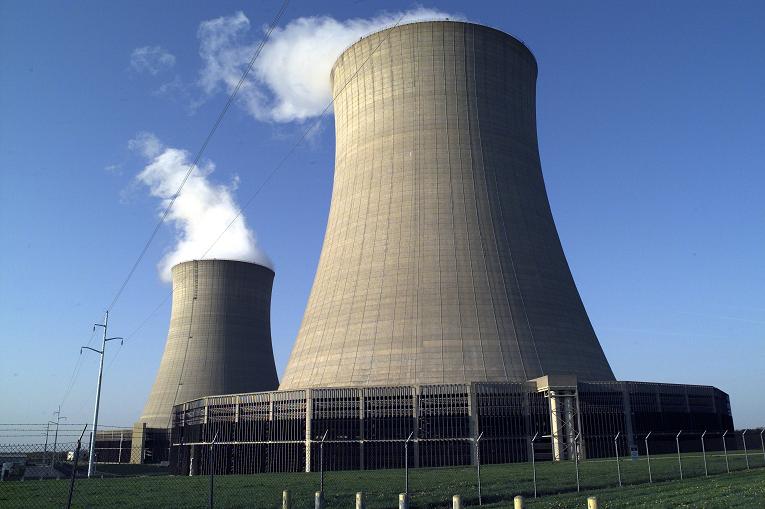
<http://www.pirateplanet.com/Byron/Twin_Towers_Wide_Angle.jpg>
Illustration 4: nuclear power plant
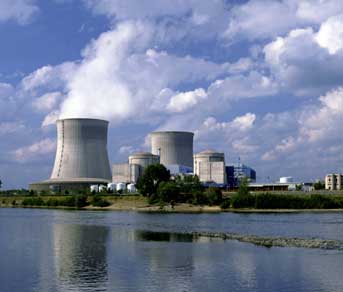
<http://www.ocrwm.doe.gov/youth/problem.htm>
Illustration 5: Three Mile Island
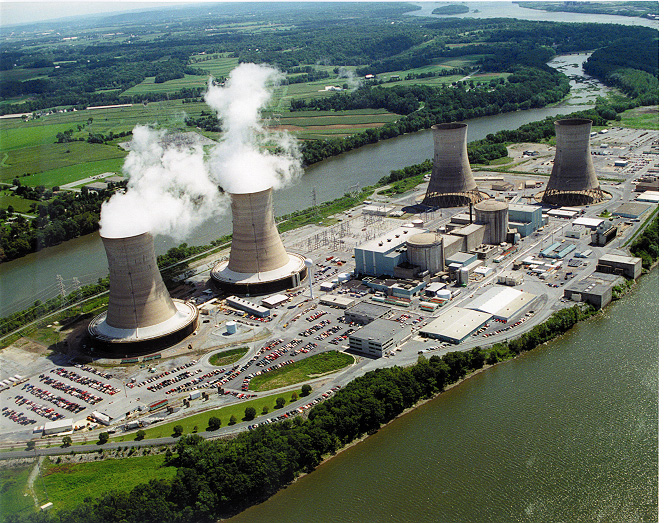
<http://www.alumni.ca/~chiuw3w/article%20images/History/three_mile_island.jpg>
Illustration 6: pressurized water reactor
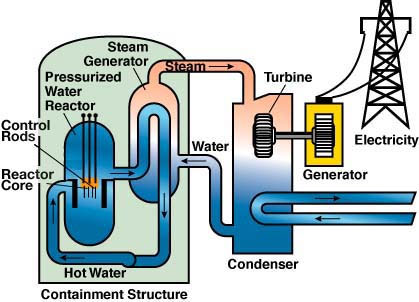
<http://www.oncorgroup.com/community/education/knowledgecollege/energy_library/elec_nuc.asp>
Illustration 7: boiling water reactor
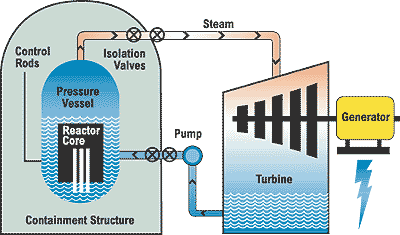
<http://www.oncorgroup.com/community/education/knowledgecollege/energy_library/elec_nuc.asp>
Illustration 8: boiling water reactor
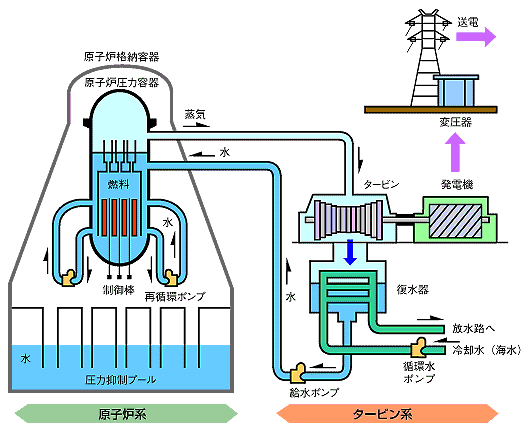
<http://www.pi.hitachi.co.jp/div/power/moreinfo/s_power/waterway/2_bwr.gif>
Illustration 9: containment building
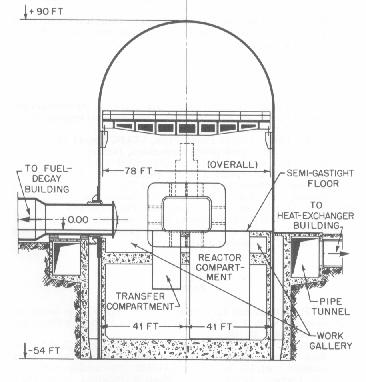
<http://www-frdb.iaea.org/photos/rapsodie/745_72.jpg>
Illustration 10: fast breeder reactor
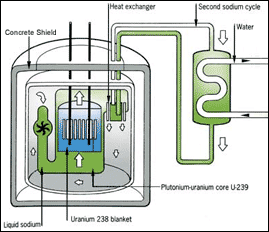
<http://www.cameco.com/common/images/u101/nr_fbr.gif>
Illustration 11: Chernobyl 131I distribution
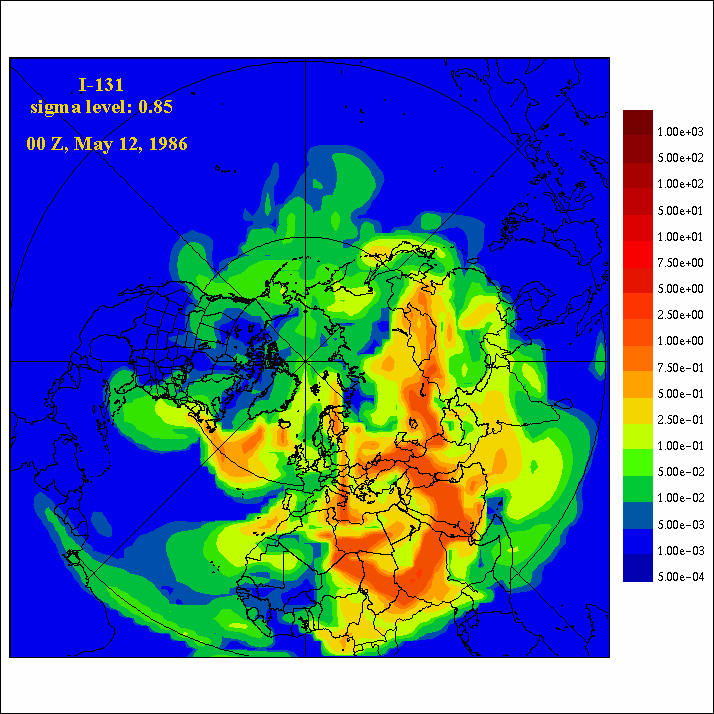
<http://www.cmc.ec.gc.ca/~arqidor/ctbto/ctbt3.html>
Works Cited